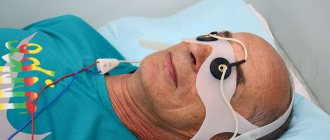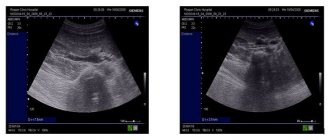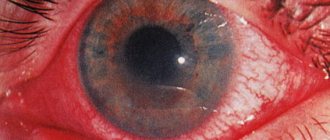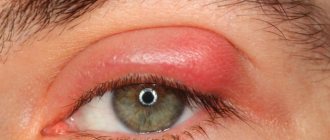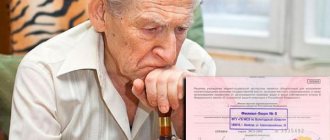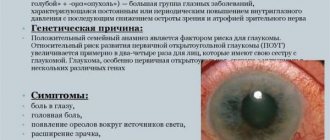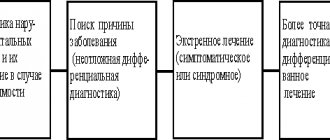Newest treatments for Parkinson's disease
Parkinson's disease: treating the incurable? The disease indicated in the title refers to degenerative neurological diseases in which neurons are destroyed and the synthesis of dopamine, one of the most important neurotransmitters, is reduced. The disease develops slowly but inevitably. It all starts with almost imperceptible symptoms - loss of smell, sweating, decreased mood, difficulty defecating. Most patients do not pay attention to this until one of the most characteristic signs of Parkinson's disease appears - slowness and stiffness of movements. As the disease progresses, stiffness of movement increases, and muscle tension develops (hypertonicity, muscles become rigid). One-sided small-amplitude trembling of the fingers and hands may occur, subsequently spreading to the other side of the body. At later stages, a person loses the ability to maintain balance and move independently, thinking slows down, and deep apathy and depression develop.
There are no drugs that can completely stop the disease. Modern therapy is aimed at alleviating the patient’s condition and slowing down the progression of the disease.
Medicines The selection of medicines for the treatment of Parkinson's disease depends on the stage of the disease. At the very beginning of the development of the disease, doctors use drugs that stimulate the synthesis of dopamine, a neurotransmitter, the amount of which decreases in parkinsonism. Drugs are also used that stop the breakdown of this neurotransmitter, prevent its reuptake, and stimulate the corresponding receptors in the brain. These drugs are in many ways similar to antidepressants.
In the early stages of the disease, dopamine receptor agonists based on the active ingredients pramipexole[1], ropinirole[2], piribedil[3], rotigotine[4], as well as MAO type B inhibitors (active ingredient rasagiline[5]) and a dopamine release activator are used from the neuronal depot - amantadine[6].
At the third of five stages of disease development, a drug with the active substance levodopa is prescribed [7]. If the disease debuted after the age of 70 years, then, as a rule, a levodopa-based drug is prescribed immediately.
Are there non-drug treatments for Parkinson's disease? Modern comprehensive treatment of Parkinson's disease also includes non-drug therapy.
Neurosurgical approach - deep brain stimulation This radical approach to the treatment of Parkinson's disease consists of stereotactically introducing electrodes into strictly defined structures of the brain. When electrical impulses are applied with a certain frequency and intensity, motor disturbances in Parkinson's disease, especially tremor, are significantly reduced. Basically, the neurosurgical approach is indicated for patients who are resistant to drug therapy. During this relatively minimally invasive (for neurosurgery) operation, some subcortical structures of the brain are destroyed. This is one of the most effective surgical treatments for Parkinson's disease.
Rehabilitation Aimed at restoring normal muscle tone. Balneotherapy, electrical stimulation, reflexology, and electrophoresis are usually prescribed. At any stage of Parkinson's disease, physical therapy is necessary to help maintain good coordination and flexibility: stretching exercises, maintaining balance, cardio training. Movement therapy helps patients adapt to the changes occurring in the body and develop the correct movement algorithms, since as the disease progresses, the old ones cease to be effective.
Rehabilitation measures are aimed at reducing anxiety levels, improving mood and combating symptoms of depression. All these signs are very characteristic of this disease.
Psychotherapy There is no doubt that Parkinson's disease significantly changes a person's life. It is very difficult to cope and come to terms with these changes. Often patients need the help of a psychotherapist. Only working with a good specialist will help overcome depression. Maintaining good spirits is one of the primary tasks facing a patient with such a diagnosis. Doctors have long noticed that the success of treatment largely depends on the patient’s mood.
General recommendations People with Parkinson's disease will have to reconsider their entire lifestyle. For example, you need to pay special attention to your diet. Digestion in this disease suffers significantly, patients often complain of constipation. To avoid this, you need to include in your diet as many fiber-rich foods as possible - vegetables and fruits, brown rice, bran bread, beans. We must not forget about proteins - best in the form of lean meat and fish, as well as eggs. Vitamins are required for normal metabolism, especially vitamins C and E. It is necessary to drink as much water as possible, since dehydration is common in Parkinson's disease.
The regimen for taking prescribed medications is also important. They must be taken exactly on the clock according to the doctor's recommendation.
New developments in the treatment of Parkinson's disease European research is being conducted in the areas of soft pulsed electrical stimulation of neurons and gene therapy. But as long as the causes of Parkinson's disease remain unclear, no cure will be found to completely cure it. Currently available treatment helps improve quality of life and delay the progression of the disease, so that patients who have recently been diagnosed with this disease have every chance of maintaining the ability to self-care for many years.
Parkinson's disease is one of the most serious illnesses for older people. In order to alleviate its manifestations and improve the general well-being of the patient, professional care and a solid material and technical base are required. Modern geriatric centers can provide all this.
Where to go for treatment for patients with Parkinson's disease? Maria Litvinova, Deputy General Director for Medical Affairs of Senior Group, says:
“We accept elderly people with Parkinson’s disease into our care and rehabilitation centers for short and long stays. The minimum is two weeks, as adaptation to new conditions will be required. A long stay can be partially paid for by the state, since our company is officially a provider of social services in Moscow and the Moscow region. Therapeutic physical education, classes on modern simulators, comfortable rooms with special orthopedic furniture, individual diet, drug therapy - all this helps a person with Parkinson's disease feel better and overcome a depressive state. We strive to maintain a relaxed, club-like atmosphere in which our guests can freely socialize with each other and their families. At the same time, round-the-clock monitoring of their condition is ensured and security measures are taken: territory navigation, video surveillance, professional security. All this meets the high requirements of Israeli geriatric protocols, according to which we work. An interdisciplinary team of doctors: a rehabilitation specialist, a geriatrician, a psychiatrist, a neuropsychologist, and exercise therapy instructors conducts daily classes with patients with Parkinson’s disease.” Original article: https://www.kp.ru/guide/lechenie-bolezni-parkinsona.html
Symptoms of Parkinsonism are disorders of movement and muscle tone and their combinations. Stiffness of movements, increased tone, tremors of the hands and head, chewing-type movements of the lower jaw, disturbances in handwriting and precision of movements, gait “bent over”, small steps, “shuffling”, poverty of facial movements - “frozen face”, decreased emotionality of behavior , depression. Symptoms of the disease, initially one-sided, further progress, in severe cases leading to disability, immobility, and cognitive impairment.
The main clinical syndrome in Parkinson's disease and parkinsonism is akinetic-rigid or hypertensive-hypokinetic. Shaking paralysis and parkinsonism are characterized by hypo- and akinesia. A peculiar flexion posture appears: the head and torso are tilted forward, the arms are half-bent at the elbow, wrist and phalangeal joints, often tightly brought to the lateral surfaces of the chest and torso, the legs are half-bent at the knee joints. Poor facial expressions are noted. The rate of voluntary movements gradually slows down with the development of the disease, sometimes complete immobility can occur quite early. The gait is characterized by small shuffling steps. There is often a tendency to involuntary run forward (propulsion). If you push the patient forward, he runs to avoid falling, as if “catching up with his center of gravity.” Often a push to the chest leads to running backwards (retropulsion) or to the side (lateropulsion). These movements are also observed when trying to sit down, stand up, or throw your head back. Often, with pronounced parkinsonism syndrome, the patient’s postures resemble cataleptic ones. Akinesis and plastic hypertension are especially pronounced in the muscles of the face, masticatory and occipital muscles, and muscles of the limbs. When walking, there are no friendly movements of the arms (acheirokinesis). Speech is quiet, monotonous, without modulation, with a tendency to fade at the end of the phrase.
During passive movement of the limb, a kind of muscle resistance is noted due to an increase in the tone of the antagonist muscles, the “gear wheel” phenomenon (the impression arises that the articular surface consists of the clutch of two gear wheels). An increase in the tone of antagonist muscles during passive movements can be determined by the following technique: if you raise the head of a person lying down, and then suddenly release your hand, the head will not fall on the pillow, but will fall relatively smoothly. Sometimes the head is slightly elevated when lying down - the “imaginary pillow” phenomenon.
Tremor is a characteristic, although not obligatory, symptom of parkinsonism syndrome. This is a rhythmic, regular, involuntary trembling of the limbs, facial muscles, head, lower jaw, tongue, more pronounced at rest, decreasing with active movements. Oscillation frequency is 4-8 per second. Sometimes finger movements in the form of “rolling pills” or “counting coins” are noted. The tremor intensifies with excitement and practically disappears in sleep.
Mental disorders are manifested by loss of initiative, activity, narrowing of horizons and interests, a sharp decrease in various emotional reactions and affects, as well as some superficiality and slowness of thinking (bradyphrenia). Bradypsychia is observed - difficult active switching from one thought to another, acairia - stickiness, viscosity, egocentrism. Sometimes paroxysms of mental excitement occur.
Autonomic disorders manifest themselves in the form of greasiness of the skin of the face and scalp, seborrhea, hypersalivation, hyperhidrosis, trophic disorders in the distal parts of the extremities. A violation of postural reflexes is detected. Sometimes special research methods are used to determine breathing that is irregular in frequency and depth. Tendon reflexes are usually without deviations. In atherosclerotic and postencephalitic parkinsonism, increased tendon reflexes and other signs of pyramidal insufficiency can be detected. With postencephalitic parkinsonism, so-called oculogyric crises occur - fixation of gaze upward for several minutes or hours; sometimes the head is thrown back. Crises can be combined with a violation of convergence and accommodation (progressive supranuclear palsy).
It is customary to distinguish several clinical forms of shaking palsy and parkinsonism; rigid-bradykinetic, tremulous-rigid and tremulous. The rigid-bradykinetic form is characterized by an increase in muscle tone according to the plastic type, a progressive slowdown of active movements up to immobility; muscle contractures and flexor posture of patients appear. This form of parkinsonism, the most unfavorable in its course, is more often observed in atherosclerotic and less often in postencephalitic parkinsonism. The trembling-rigid form is characterized by tremor of the extremities, mainly their distal parts, which is accompanied by stiffness of voluntary movements as the disease develops. The trembling form of parkinsonism is characterized by the presence of constant or almost constant medium- and large-amplitude tremor of the limbs, tongue, head, and lower jaw. Muscle tone is normal or slightly increased. The tempo of voluntary movements is maintained. This form is more common in postencephalitic and posttraumatic parkinsonism.
A person's movements, muscle control and balance of the body in space are impaired. This condition is formed precisely due to the destruction of the accumulation of part of the nerve cells (substantia nigra) of the brain stem. These nerve cells are connected by their fibers to both hemispheres of the brain. They produce and release special substances (neurotransmitters) that help control the movements and coordination of the body in space. Their absence leads to the appearance of such outwardly noticeable signs of parkinsonism as a decrease in the range of movements with an increase in muscle tone, trembling of the limbs, a mask-like facial expression, walking in small steps and similar symptoms.
